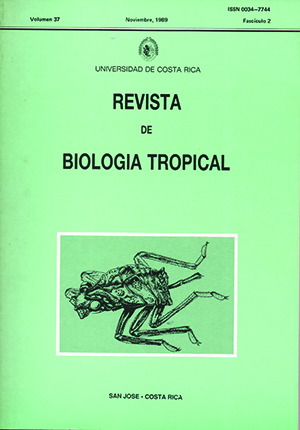Abstract
A survey on!he prevalence of Ascaris lumbricoides, Trichuris trichiura and Hymenolepis nana was conducted in two adjacent, but sociocconomically distinct, urban Costa Rican cornmunities: a squatter settlement and a community with access to modern sewage facilities. The prevalence of these infections was significantly higher in the former. Although squatter children (1-14 years old) were more heavily infected with A. lumbricoides and H. nana than squatter adults, the same pattern was not observed for T. irichiura. The results suggest that local community-based helminthic parasite surveys may more accurately portray the actual health status of socioeconomically diverse urban populations.
References
Aggarwal, O. P., P. V. Gulati & R. A. Bhujwala.1972. Study of intestinal helminthic infections in relation to environmental sanitation, personal habits and socio-economic status in New Delhi. Indian J. Prev. Soc. Med. 3:230- 233.
Anonymous. 1986. La crisis económica y su repercusión en la salud. Bol. Of. Sanit. Panam. 100: 648-659
Arfaa, F. 1984. Selective primary health care: Strategies for control of disease in the developing world. XII. Ascariasis and trichuriasis. Rev. Infec. Dis. 6:364-373.
Bhandari, B., G. P. Gupla & S. L Mandowara. 1985. Prevalence of intestinal parasites in Udaipur. Indian J. Pediat. 52: 299-302.
Cohen, S. & E. H. Sadun. 1976. Immunology of Parasitic Infections. Blackwell Scientific Publications, Oxford, pp. 401.
Dunn, F. L 1979. Behavioural aspects of the control of parasitic diseases. Bull. World Health Organization 57: 499-512.
Embil, J. A., L. H. Pereira, F. M. M. White, B. J. Gamer & F. R. Manuel. 1984. Prevalence of Ascaris lumbricoides infection in a small Nova Scotian community. Amer. J. Trop. Med. Hyg. 33: 595-598.
Jaramillo, J. G. Pineda & G. Contreras 1984. Atención primaria de salud en zonas urbanas marginales. El modelo de Costa Rica. Bol. Of. Sanit. Panam. 97:189-198.
Khanna, S., P. Brandon & C. Puentes. 1984. Salud en zonas urbanas de América Latina y del Caribe. Bol. Oc. Sanit. Panam. 96: 134- 199.
Kilpatrick, M. E., J. Escamilla, A. B. Townsend, W. G. López, E. P. Vargas & L. B. Castillo 1986. Parasitosis intestinales identificadas mediante examen de heces en tres grupos de población de Perú Bol. Of. Sanit. Panam. 100: 412-415.
Mata, L., B. Pardo, F. Hemández, C. Albertazzi, M. Visconti, A. Mata, R. Femández, E. Nuñez & M. Vizcaino. 1985. Cambios en la prevalencia de helmintos en Costa Rica 1966-1982, p. 208-220 In: Control and Eradication of Infectious Diseases. An International Symposium. PAHO Copubl. Ser. No. 1, Pan American Heahh Organization, Washinton, Washington, D. C.
Neghme, A. & R. Silva. 1963. Estado actual de la infecciones por Ascaris lumbricoides y Trichuris irichiura en la Ciudad de Santiago de Chile 1. Encuestas epidemiológicas. Bol. Chileno Parasitol. 18:54-60.
Robens, B. 1979. Cities of Peasants: The Political Economy of Urbanization in the Third World. Sage Publ¡cations, London. 137 p.
Silva, R. 1965. Alcances ecológicos en la epidemiología de las enfermedades parasitarias. Bol. Chileno Parasitol. 20: 113-122.
Stoll, N. R. 1923. Investigation on the control of hookworm disease. XV. An effective method of counting hookwonn eggs in feces. Amer. J. Hyg. 3:59-70.
Souza-Días, L. C. 1981. Geohelmintiasis en Brasil. Bol. Chileno Parasitol. 36:27-28.
Thein-Hlaing, Than-Saw, Htay-Htay-Aye, Myint-Lwin & Thcin-Maung-Myint. 1984. Epidemiology and transmission dynamics of Ascaris lumbricoldes in Okyo Village, rural Burma. Trans. Roy. Soc. Trop. Med. 78:497-504.
Thompson, R. 1985. World Urbarnization. Vol 1: Thedaily and Reminder Services, Thursday, March 7, In: H. Gimlin, (ed.) Editorial Research Reports Congressional Quarterly Inc, Washington, D. C.
Vanden Bossche, H. 1984. Economic aspects of parasitic diseases: proceedings of an international workshop. Soc. Sc. Med. 19: 1013-1126.
Wilkie, J. W. & D. Lorey. 1987. Statistical Abstract of Latín
America. UCLA Latin American Center Publications, University of California, Las Angeles. 120 p.
World Health Organization. 1981a. WHO Expen Cornmittee on Prevention and Control of Intestinal Protozoan and Helminthic lnfections. WHO Tech. Rep. Ser. 666, Geneva. p. 7.
World Health Organization. 1981b. WHO Expert Committee on Prevention and Control of Intestinal Protozoan and Helminthic Infections. WHO Tech. Rep. Ser. 666, Geneva. p. 23.
World Health Organization. 1981c. WHO Expert Committee on Prevention and Control of Intestinal Protozoan and Helminthic Infections. WHO Tech. Rep. Ser. 666, Geneva. p. 23.
World Health Organization. 1981d. WHO Expert Committee on Prevention and Control of Intestinal Protozoan and Helminthic Infections. WHO Tech. Rep. Ser. 666, Geneva. p. 98.
World Health Organization. 1987a. WHO Expert Cornmittee on Prevention and Control of Intestinal Parasitic lnfections. WHO Tech. Rep. Ser. 749, Geneva. p. 28.
World Health Organization.1987b. WHO Expert Committee on Prevention and Control of Intestinal Parasitie Infections. WHO Tech. Rep. Ser. 749, Geneva. p. 34.
##plugins.facebook.comentarios##

This work is licensed under a Creative Commons Attribution 4.0 International License.
Copyright (c) 1989 Revista de Biología Tropical


